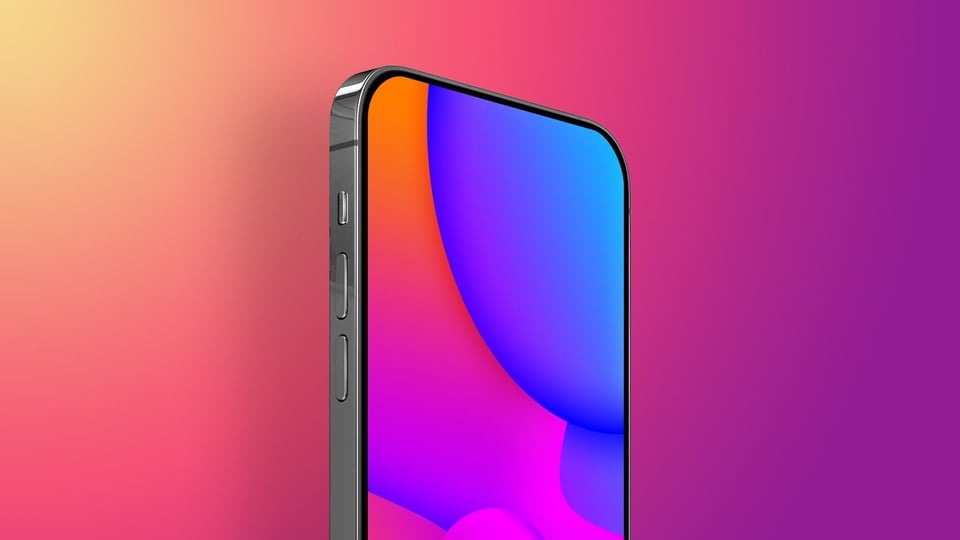 |
The iPhone without a screen notch may be launched on the 20th anniversary. Photo: MacRumors . |
According to Bloomberg reporter Mark Gurman, Apple is preparing a "bold" iPhone Pro model for the 20th anniversary of the iPhone launch in 2027.
As part of a “major overhaul” for the future of the soon-to-be 20-year-old smartphone brand, leaks suggest that Apple is working on a design that uses more glass, directly referencing the display.
Roadmap of the notchless display
Gurman recently mentioned that the iPhone Pro will have a smaller Dynamic Island in 2026 or 2027, as Apple moves more of the front-facing components below the display.
While it's unclear whether the selfie camera or the TrueDepth system will change first, analyst Ross Young says under-display Face ID is planned for a 2026 launch.
 |
After Dynamic Island, the notch on the iPhone screen may continue to shrink and be eliminated. Photo: MacRumors. |
If this information is accurate, under-screen Face ID could appear as early as next year, on the iPhone 18 Pro and iPhone 18 Pro Max. In that case, the Dynamic Island would shrink but remain the same, housing the front camera through a small hole.
The next logical step for the 2027 flagship is to move that camera below the screen, finally achieving the long-awaited full-screen design. That timeline also fits with Young's predicted roadmap for iPhone screen design changes starting in 2023.
Another leaker has also revealed similar plans. On Weibo, Digital Chat Station claimed that the next two generations of iPhones – iPhone 17 and iPhone 18 – will retain Dynamic Island. However, with the 2027 model, Apple will complete the transition to a screen without a notch.
Technical barriers
Whether or not an iPhone with an under-screen camera will appear on the 20th anniversary of the product line will depend largely on technical progress at Apple.
For Face ID to work under the screen, the feature’s sensors—particularly those that use infrared light—need to work without being interfered with by the display layers above. That’s difficult with current OLED and LCD technology, which tend to scatter or absorb infrared signals.
 |
Currently, Face ID sensors need to occupy a certain position on the iPhone screen. Photo: MacRumors. |
However, there are some new display technologies that could make this possible. Transparent OLED panels can allow infrared light to pass through specific areas of the screen. However, some devices that currently use this method suffer from reduced brightness and clarity.
LTPO displays with sub-pixels that can be temporarily disabled would also allow sensors to “see” through the panel during authentication. Another possibility involves integrating optical waveguide layers into the display to carry infrared signals to and from the sensors.
Apple could also incorporate advanced IR-pass materials to create an invisible sensing area, helping to ensure display quality while still allowing for accurate facial recognition.
If Apple intends to celebrate the 20th anniversary of the iPhone with a hardware step similar to 2017's iPhone X — the first iPhone to ditch the Home button and introduce Face ID — then an all-screen design would certainly make a splash.
As for naming, it's unclear whether Apple will continue with the annual numbering, meaning iPhone 19 in 2027, or opt for a commemorative name like "iPhone 20" to match the milestone year.
In 2017, to celebrate the 10th anniversary of the iPhone, the company introduced the special edition iPhone X with a completely new design.
Source: https://znews.vn/dieu-dac-biet-cua-chiec-iphone-ki-niem-20-nam-post1546147.html


![[Photo] Binh Trieu 1 Bridge has been completed, raised by 1.1m, and will open to traffic at the end of November.](https://vphoto.vietnam.vn/thumb/1200x675/vietnam/resource/IMAGE/2025/10/2/a6549e2a3b5848a1ba76a1ded6141fae)






























































































Comment (0)